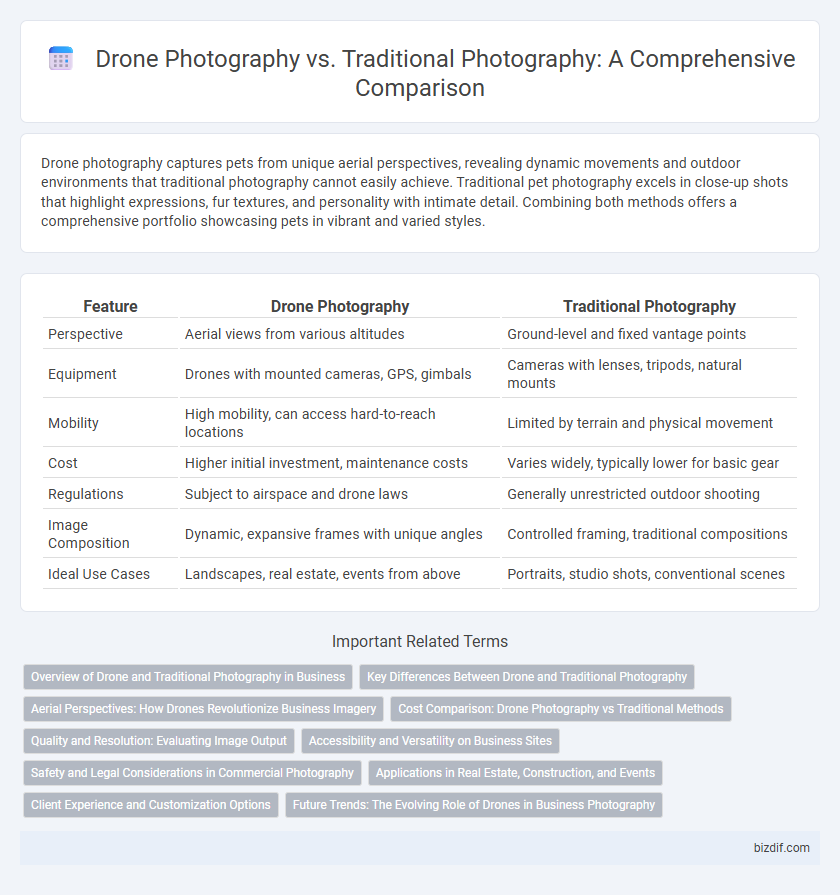Drone photography captures pets from unique aerial perspectives, revealing dynamic movements and outdoor environments that traditional photography cannot easily achieve. Traditional pet photography excels in close-up shots that highlight expressions, fur textures, and personality with intimate detail. Combining both methods offers a comprehensive portfolio showcasing pets in vibrant and varied styles.
Table of Comparison
| Feature | Drone Photography | Traditional Photography |
|---|---|---|
| Perspective | Aerial views from various altitudes | Ground-level and fixed vantage points |
| Equipment | Drones with mounted cameras, GPS, gimbals | Cameras with lenses, tripods, natural mounts |
| Mobility | High mobility, can access hard-to-reach locations | Limited by terrain and physical movement |
| Cost | Higher initial investment, maintenance costs | Varies widely, typically lower for basic gear |
| Regulations | Subject to airspace and drone laws | Generally unrestricted outdoor shooting |
| Image Composition | Dynamic, expansive frames with unique angles | Controlled framing, traditional compositions |
| Ideal Use Cases | Landscapes, real estate, events from above | Portraits, studio shots, conventional scenes |
Overview of Drone and Traditional Photography in Business
Drone photography offers dynamic aerial perspectives that enhance marketing campaigns and real estate presentations, providing unique vantage points inaccessible through traditional methods. Traditional photography relies on established techniques and controlled environments to capture high-quality, detailed images essential for product showcases and portraits. Integrating both approaches can significantly elevate visual content quality, driving greater engagement and business growth.
Key Differences Between Drone and Traditional Photography
Drone photography captures aerial perspectives using unmanned aerial vehicles equipped with high-resolution cameras, allowing for dynamic, sweeping shots often unattainable by traditional photography. Traditional photography relies on handheld or tripod-mounted cameras, focusing on ground-level compositions and controlled lighting, emphasizing detail and subject intimacy. Key differences include vantage points, mobility, and technical constraints, with drones offering expansive, elevated views and traditional photography excelling in precision and close-range detail.
Aerial Perspectives: How Drones Revolutionize Business Imagery
Drone photography offers unparalleled aerial perspectives that traditional photography cannot achieve without expensive equipment like helicopters or cranes. Businesses now capture expansive landscapes, real estate properties, and large events from dynamic angles, enhancing marketing appeal and client engagement. This innovation revolutionizes imagery by providing high-resolution, bird's-eye views that drive impactful visual storytelling and data collection.
Cost Comparison: Drone Photography vs Traditional Methods
Drone photography generally offers a cost-effective alternative to traditional photography by reducing the need for expensive equipment such as cranes or helicopters. Traditional methods often incur higher costs due to staffing, equipment rental, and time for setup, whereas drones streamline operations with lower maintenance and quicker deployment. Budget-conscious projects can significantly benefit from drones' affordability without compromising on image quality or perspective.
Quality and Resolution: Evaluating Image Output
Drone photography captures high-resolution images with unique aerial perspectives, often surpassing traditional photography in coverage scope and dynamic range. Traditional photography excels in detailed close-ups and controlled lighting, providing superior sharpness and color accuracy for portrait and studio shots. Image output quality depends on equipment specifications, sensor size, and shooting conditions, with drones leveraging advanced stabilization and multi-sensor arrays to enhance resolution and clarity.
Accessibility and Versatility on Business Sites
Drone photography offers unparalleled accessibility for capturing expansive business sites, enabling detailed aerial views that traditional photography cannot achieve. Its versatility allows businesses to showcase properties from dynamic angles, enhancing marketing materials and providing comprehensive site surveys with efficiency. Traditional photography remains valuable for close-up, human-centric shots but lacks the broad spatial coverage and rapid deployment advantages of drones.
Safety and Legal Considerations in Commercial Photography
Commercial drone photography requires strict adherence to aviation regulations, including obtaining FAA Part 107 certification and respecting no-fly zones to ensure operational safety. Traditional photography relies less on regulatory compliance but demands careful management of physical environments to avoid accidents or property damage. Compliance with privacy laws is critical in both methods to protect subjects' rights and prevent legal liabilities during commercial shoots.
Applications in Real Estate, Construction, and Events
Drone photography offers unparalleled aerial perspectives, enabling real estate agents to showcase property layouts and surroundings with comprehensive visuals that traditional photography cannot capture. In construction, drones provide real-time progress monitoring and site inspections, improving safety and efficiency compared to manual methods. For events, drone photography delivers dynamic, wide-angle shots that capture large crowds and venue scale, enhancing coverage beyond standard ground-level images.
Client Experience and Customization Options
Drone photography offers clients dynamic aerial perspectives and real-time image adjustments, enhancing engagement and satisfaction. Traditional photography provides personalized interaction through direct communication and tailored setups, allowing detailed customization of lighting and composition. Both methods deliver unique client experiences, with drones excelling in expansive views and traditional techniques excelling in controlled, intimate shots.
Future Trends: The Evolving Role of Drones in Business Photography
Drone photography is revolutionizing business marketing by providing dynamic aerial perspectives that traditional photography cannot capture, enhancing visual storytelling and client engagement. Advances in drone technology such as AI-powered image processing and longer flight times are driving widespread adoption across real estate, construction, and event industries. Future trends predict integration with augmented reality and real-time data analytics, positioning drones as indispensable tools for innovative business photography strategies.
Drone Photography vs Traditional Photography Infographic

 bizdif.com
bizdif.com